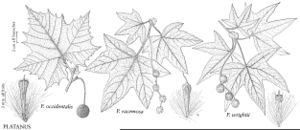Platanus
Sp. Pl. 2: 999. 175.
Gen. Pl. ed. 5, 433. 1754.
| Taxon | Illustrator ⠉ | |
|---|---|---|
 | Platanus wrightii Platanus racemosa Platanus occidentalis | John Myers John Myers John Myers |
Leaves, twigs, and inflorescences densely invested with dendritic trichomes, at least when young; fragrance sometimes reminiscent of balsam poplars. Staminate flowers: sepals and petals 3-6+, petals nearly obsolete; pistillodes sometimes present; stamens as many as and opposite sepals, much exceeding tiny perianth, anthers subsessile, 4-sporangiate; dehiscence latrorse, the connective distally expanded into terminal, pubescent, peltate appendage. Pistillate flowers: sepals 3-4, petals absent; staminodes 3-4, prominent, club-shaped, tomentose; pistils 3-9, free; ovules 1 (-2), pendulous, orthotropous; stigma 1, dark red, much elongate, conspicuous. Achenes falling with ring of subtending hairs attached.
Discussion
In North America Platanus is usually called sycamore, a name apparently borrowed from the European sycamore maple, Acer pseudoplatanus Linnaeus, which has similar leaves. That name in turn comes from the Middle Eastern sycomore fig, Ficus sycomorus Linnaeus, its specific epithet from the Greek sykomoros, mulberry.
Selected References
None.
Lower Taxa
Key
| 1 | Leaf sinuses usually broad and gently concave, depth of distal sinuses mostly less than 1/2 distance from sinus to base of blade; terminal lobe mostly wider than long, margins entire to coarsely serrate; fruiting heads 1(–2); e North America, ne Mexico, widely cultivated. | Platanus occidentalis |
| 1 | Leaf sinuses narrow to broad, deeply concave, depth of distal sinuses more than 1/2 distance from sinus to base of blade; terminal lobe longer than wide, margins entire to remotely serrulate; fruiting heads (1–)2–7 on rachis; sw United States, nw Mexico. | > 2 |
| 2 | Terminal leaf lobe 1/3–2/3 length of blade; leaf blade abaxially persistently tomentose, adaxially glabrescent; fruiting heads (1–)2–7 on rachis, lateral ones sessile; California, Mexico (Baja California). | Platanus racemosa |
| 2 | Terminal leaf lobe 2/3 or more length of blade; leaf blade abaxially and adaxially glabrescent; fruiting heads (1–)2–4 on rachis, lateral ones sessile or often pedunculate; Arizona, New Mexico; Mexico (Chihuahua, Sinaloa, and Sonora). | Platanus wrightii |
"thin" is not a number.